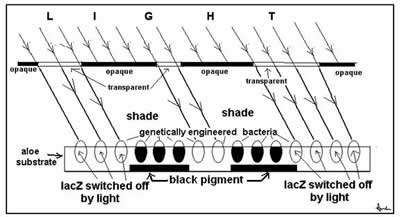Photo film does the comeback with biological film
By - S.AnanthanarayananPhotographers of wildlife will feel good that the next improvement in the quality of pictures may come thanks to living things – bacteria. This is in the form of film based on light-sensitive bacteria helping photo-film regain the place it once had till digital photography took the lead.
In the early days of digital photography, it was still believed that despite convenience and easy processing of the digital picture, in quality and speed the photo film was superior. But rapid improvement of digital photography has proved this wrong and the digital camera now matches the chemical film camera in every respect.
The Chemical film
This was based on crystals of silver iodide, or similar substances, suspended in celluloid film. The silver-iodine combination is tenuous and even photons of light can break the bond, to leave metallic silver behind. When light fell on a film, a ‘latent' image, of metallic silver deposit was left where the light was strong. The parts of the film where light had not fallen were washed away in ‘developing and fixing' and the opacity that remained where the light had fallen was the ‘negative'.
In colour photography, there are three kinds of photo-materials, each sensitive to red, green or blue light. With the three kinds spread over layers, all shades of colours could be captured, according to the numbers of the different photo-materials affected.
The limit to how sharp the images could be was defined by how small the crystals of the photo-material could be. The best films, with the finest crystals, had a grain size between 8 and 11 microns (a micron is a thousandth of a millimeter). We can readily see that detail finer than about the grain size could not be captured.
Digital photography
In the place of photo-sensitive crystals, usually randomly distributed, the digital camera screen uses an array of photo-sensitive electronic elements. The output from each element, during an exposure, is a record of the intensity of light falling on that element. An electronic circuit can then record the output of all the elements in the array and this list of numbers becomes the ‘image'. For display, the numbers are converted to optical output from light emitting elements in a display screen. Or the numbers could be passed to a printer, or even to expose a photographic film.
We can imagine that electronic imaging and display elements would be cumbersome and were not likely to match the delicacy possible with crystals. It is the marvel of advances in micro circuitry that ‘pixels' or sensitive elements in unit area of a digital screen, have grown so much that the equivalent of a grain size of nearly 5 microns has become possible. Photographers who use both photo-film and digital photography now find little to choose between the two in quality of output. And digital photography has obvious advantages of ease of handling and manipulation.
Enter biological film
Christopher Voigt and colleagues, at the California Institute of Technology have created a light sensitive mat consisting of a genetically modified version of the bacterium e-coli. The scientists first used a strain of the bacterium that contains a gene called lacZ, which makes it capable of producing a black pigment. The bacterium was then made light sensing by adding a gene from a light sensitive organism called cyanobacterium, using methods of genetic engineering.
The components of the bacterium were so aligned that the photoreceptor interfered with the expression of lacZ and prevented the black pigment from being produced. A lawn of these bacteria grown on a base of wax could then hold an image of a light pattern, by keeping illuminated portions light, while the dark portions turned black!

The e-coli bacterium is about 2 microns long and less than a micron across. This enables much finer sensitivity to detail and the effective pixels count is about 10 times better than good digital photographs. When the biofilm becomes commercially available it may bring back the older kind of photography with sharper detail and better contrast!
[the writer can be contacted at simplescience@gmail.com]









0 Comments:
Post a Comment
<< Home